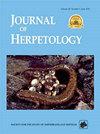Morphometric Variability in Lizards of the Genus Teius: A Comparative Study of Species with Different Reproductive Modes
IF 0.8
4区 生物学
Q3 ZOOLOGY
引用次数: 0
Abstract
Abstract. The lizard genus Teius is widely distributed in lowland areas to the east of the Andes in southern South America and includes three species: Teius teyou, T. oculatus, and T. suquiensis. All three Teius species are broadly similar in morphological characters, the dorsal coloration pattern being the best feature to distinguish them. Furthermore, T. suquiensis are parthenogenetic, whereas the other two are bisexual. We applied 2D geometric morphometric methods on head morphology to measure and compare variability between these clonally and sexually reproductive lizards and to assess form variability among populations within the parthenogenetic species. We studied 181 adult females of the three species from across a wide range of their distributions. Geometric morphometrics successfully separated them in the morphospace. The three Teius presented similar head size; hence, the differences found are related to shape. Teius teyou has a shorter snout and a narrower posterior area of the head whereas T. oculatus has a longer snout and a wider posterior area of the head, and T. suquiensis shows an intermediate phenotype. Levels of morphological variability among the species were similar and independent of reproductive mode. Differences in head size and shape among populations were observed within T. suquiensis, despite its clonal inheritance. The observed variability might be explained by populations that are composed of different clonal lineages, populations that showed different responses to varying local environmental factors, or both. Additional morphological studies considering genetic diversity and habitat characteristics may clarify the factors that promote morphological variability in the genus, especially in the parthenogenetic species.Teius属蜥蜴的形态变异性:不同繁殖模式物种的比较研究
摘要Teius属蜥蜴广泛分布于南美洲南部安第斯山脉以东的低地地区,包括Teius teyou、T. oculatus和T. suquiensis三种。三种Teius在形态特征上大致相似,背部颜色模式是区分它们的最佳特征。此外,suquiensis是孤雌生殖,而其他两种是双性恋。我们应用二维几何形态测量方法测量和比较这些无性繁殖和有性繁殖的蜥蜴的头部形态差异,并评估孤雌生殖物种种群之间的形态差异。我们研究了这三个物种的181个成年雌性,分布范围很广。几何形态计量学成功地在形态空间中分离了它们。三只泰乌斯的头部大小相似;因此,发现的差异与形状有关。Teius teyou的鼻部较短,头后区域较窄,而T. oculatus的鼻部较长,头后区域较宽,而T. suquiensis则表现为中间表型。物种间的形态变异水平相似,且与生殖方式无关。在苏奎白蚁种群中,尽管存在无性遗传,但其头的大小和形状在种群间存在差异。观察到的变异可能是由不同克隆系组成的群体,对不同的当地环境因素表现出不同的反应,或两者兼而有之。进一步的形态学研究考虑了遗传多样性和生境特征,可能会澄清促进该属,特别是孤雌生殖物种形态变异的因素。
本文章由计算机程序翻译,如有差异,请以英文原文为准。
求助全文
约1分钟内获得全文
求助全文
来源期刊

Journal of Herpetology
生物-动物学
CiteScore
1.60
自引率
0.00%
发文量
45
审稿时长
6 months
期刊介绍:
The Journal of Herpetology accepts manuscripts on all aspects on the biology of amphibians and reptiles including their behavior, conservation, ecology, morphology, physiology, and systematics, as well as herpetological education. We encourage authors to submit manuscripts that are data-driven and rigorous tests of hypotheses, or provide thorough descriptions of novel taxa (living or fossil). Topics may address theoretical issues in a thoughtful, quantitative way. Reviews and policy papers that provide new insight on the herpetological sciences are also welcome, but they must be more than simple literature reviews. These papers must have a central focus that propose a new argument for understanding a concept or a new approach for answering a question or solving a problem. Focus sections that combine papers on related topics are normally determined by the Editors. Publication in the Long-Term Perspectives section is by invitation only. Papers on captive breeding, new techniques or sampling methods, anecdotal or isolated natural history observations, geographic range extensions, and essays should be submitted to our sister journal, Herpetological Review.
 求助内容:
求助内容: 应助结果提醒方式:
应助结果提醒方式:


